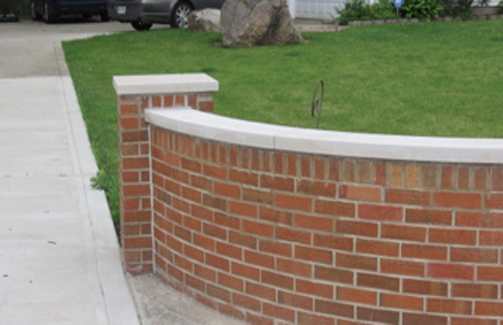Why Repair Brick or Stone
If you have ever had to repair brick masonry or stone masonry walls then you know how complicated and expensive it can be to do so. As it is always best to replace damaged or failed masonry units with new masonry, often times the budget dictates otherwise. So, is patching and/or staining brick masonry or stone masonry units an acceptable process? Let’s first answer the question of why would we repair brick masonry or stone masonry walls – Why is it so critical in the first place.
The building envelope or shell is the main structural component along with the roof and foundation of any structure whether it be a home, office building, store, theatre, industrial warehouse, or a church. The main purpose of the exterior building envelope is to provide a safe strong structure and security for the building. It is crucial that any properly designed and built structure protects the interior and it’s occupants from the elements such as wind, rain, snow, ice, UV rays, heat, cold, etc. In many cases, buildings have some type of masonry facade–brick masonry, stone masonry, cultured or man-made faux stone, block, stucco and/or exterior insulated finish systems (EIFS) that is a synthetic stucco with foam as the backer-board over OSB/plywood, etc.
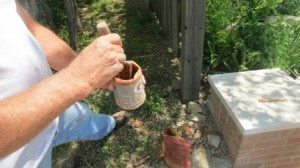 One of the main functions of any exterior masonry facade is to keep the building dry, that is, water-tight. So, as weather and age has an adverse affect on the brick masonry or stone masonry walls, it is only natural to have to repair brick masonry or other exterior masonry walls on a regular basis to maintain its structural integrity, keep the interior dry, and make it cosmetically pleasing. When a building has leaks, and/or masonry is failing via spalling brick or stone from water-damage caused by freeze-thaw cycles, it is very important you discuss the proper means and methods of restoring the masonry with an experienced masonry restoration and/or building renovation contractor. An experienced contractor will be able to explain all the specific problems with your particular masonry facade(s) and give you detailed options/solutions to repair brick masonry or repair/replace any and all types of masonry in question. In theory, a contractor that is financially sound and stable will typically be very direct and honest with you about what needs done to maintain the structural integrity of the masonry walls while providing viable options and solutions between repairing or replacing masonry units such as brick, stone, block, stucco, et. al., for there is no incentive to pull your leg and over-charge you, etc. Well, except for greed. Buyer beware!
One of the main functions of any exterior masonry facade is to keep the building dry, that is, water-tight. So, as weather and age has an adverse affect on the brick masonry or stone masonry walls, it is only natural to have to repair brick masonry or other exterior masonry walls on a regular basis to maintain its structural integrity, keep the interior dry, and make it cosmetically pleasing. When a building has leaks, and/or masonry is failing via spalling brick or stone from water-damage caused by freeze-thaw cycles, it is very important you discuss the proper means and methods of restoring the masonry with an experienced masonry restoration and/or building renovation contractor. An experienced contractor will be able to explain all the specific problems with your particular masonry facade(s) and give you detailed options/solutions to repair brick masonry or repair/replace any and all types of masonry in question. In theory, a contractor that is financially sound and stable will typically be very direct and honest with you about what needs done to maintain the structural integrity of the masonry walls while providing viable options and solutions between repairing or replacing masonry units such as brick, stone, block, stucco, et. al., for there is no incentive to pull your leg and over-charge you, etc. Well, except for greed. Buyer beware!
Repair Masonry vs Replace Masonry
Now that we understand water is the one of the main things that harms brick masonry or stone masonry and is considered evil, we need to determine if there is any real benefit to repair brick masonry or any other type of masonry via patching and/or staining masonry units in lieu of removing and replacing it. Of course, removing and replacing damaged masonry is without question the best course of action and should be done at all costs whenever possible. However, since the downturn of our economy, many building owners, property managers, home owners, church congregations, etc. simply do not have adequate enough capital or resources to always do it the best way. Thus, there is another way that is cost effective and, if done properly (and this is the key), will keep the water out, maintain the structure and pass the “aesthetic” test.
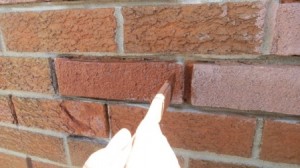 it is quite common these days to repair brick masonry and other types of masonry via patching rather than complete removal and replacement of the masonry solely due to budgetary restraints. While a full replacement of masonry units will last decades, a properly repaired/patched masonry unit/wall will last nearly a decade or sometimes even longer at approx. half the costs of full replacement. As most people do not stay in their homes, own a building, etc. that long then this it is often the course of action they choose. As a responsible party to the restoration process, a contractor should always be willing to provide realistic and viable options and solutions that will serve the customers’ needs and wants both in the short-term and long-term based on what actually needs done to remedy any masonry leaks, make the wall(s) structurally safe, and make the property look good again. Thus, patching is a viable solution. However, not all patching materials and/or those skilled individuals doing the patching are equal.
it is quite common these days to repair brick masonry and other types of masonry via patching rather than complete removal and replacement of the masonry solely due to budgetary restraints. While a full replacement of masonry units will last decades, a properly repaired/patched masonry unit/wall will last nearly a decade or sometimes even longer at approx. half the costs of full replacement. As most people do not stay in their homes, own a building, etc. that long then this it is often the course of action they choose. As a responsible party to the restoration process, a contractor should always be willing to provide realistic and viable options and solutions that will serve the customers’ needs and wants both in the short-term and long-term based on what actually needs done to remedy any masonry leaks, make the wall(s) structurally safe, and make the property look good again. Thus, patching is a viable solution. However, not all patching materials and/or those skilled individuals doing the patching are equal.
Use Only Quality Masonry Materials
So, it is very important the consumer selects the best possible contractor in their area to perform the patching of their masonry brick, stone, block, stucco, etc. For the preparation and application of the patching method are both vital to the short-term solution to repair brick masonry or any type of masonry. For obvious reasons, a patch is not going to last as long as a full-blown replacement. Hence, it is critical one can get as much longevity out of a patch job as possible. There are some very good patching compounds on the market today such as Cathedral Stone’s Jahn Mortars and Mimic by Matrix that are used on important historical buildings, landmarks, parks, etc. These are often used by only the best restoration companies as well even on small residential and commercial projects in Central Ohio. So, if trying to do patch work due to budget constraints, at least, use a good company that applies the best products. Also, only the best applicators are trained in these high-end products and are typically very good technicians. This vastly increases the chances of the patch work lasting a lot longer. This buys you time to save and be able to replace the bad masonry with new masonry one day or sell the place in the meantime.
Patch and Stain Brick
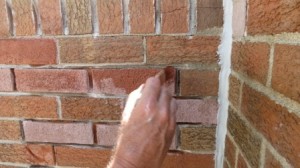 If you simply need some common brick patched and stained to match the existing on your walls then a simple fairly inexpensive mortar mix for the patching is fine as long as the masonry unit is prepared the right way. The key is to get the surface of the unit being patched roughed up, indented, etc. with lots of jagged edges, holes and/or ridges of at least 1/4” to 1/2” depth all along or over it’s face as well as cleaned and made dust free so the new mortar or patch will easily adhere or bond to it, etc. Then, apply a thin slurry or parge coat over it and allow it to set up or harden some while shaping it, etc. After that, the patch needs filled to make even with the masonry unit surface matching finish and texture as close as possible. Allow the last bit of mortar to dry some and then mix in the dye or pigment with water and some mortar and/or aggregate depending on desired finished appearance of masonry and apply it with a brush to the patch in even thick coats/strokes. This will penetrate the mortar or patch material and it will need applied several times in most cases. Once the desired finish and color is met on the patching and staining, it is best to give the new patch/stain at least 48 hours to cure out before rinsing down with some water if necessary. Lastly, after waiting several days, it is usually best to apply a clear water repellent over the new masonry patches as this will help protect the patch and stop water from getting in behind it as the surrounding mortar joints and masonry units in the wall will be sealed as well.
If you simply need some common brick patched and stained to match the existing on your walls then a simple fairly inexpensive mortar mix for the patching is fine as long as the masonry unit is prepared the right way. The key is to get the surface of the unit being patched roughed up, indented, etc. with lots of jagged edges, holes and/or ridges of at least 1/4” to 1/2” depth all along or over it’s face as well as cleaned and made dust free so the new mortar or patch will easily adhere or bond to it, etc. Then, apply a thin slurry or parge coat over it and allow it to set up or harden some while shaping it, etc. After that, the patch needs filled to make even with the masonry unit surface matching finish and texture as close as possible. Allow the last bit of mortar to dry some and then mix in the dye or pigment with water and some mortar and/or aggregate depending on desired finished appearance of masonry and apply it with a brush to the patch in even thick coats/strokes. This will penetrate the mortar or patch material and it will need applied several times in most cases. Once the desired finish and color is met on the patching and staining, it is best to give the new patch/stain at least 48 hours to cure out before rinsing down with some water if necessary. Lastly, after waiting several days, it is usually best to apply a clear water repellent over the new masonry patches as this will help protect the patch and stop water from getting in behind it as the surrounding mortar joints and masonry units in the wall will be sealed as well.
The process to repair brick masonry, stone masonry and all other types of masonry is fairly simple, quick, and inexpensive. If done properly, it can last a long time as well. While it’s not the ideal way to repair failed masonry, it is an acceptable method and one that will save both time and money while serving the purpose of making the masonry water-tight and still improving the aesthetics of the masonry facade(s).
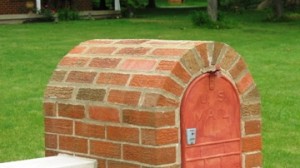 How does one find an honest, direct, very experienced and highly skilled masonry or building restoration company in your area? Search for these reputable companies at the Better Business Bureau, Angie’s List, Blue Book of Construction, Christian Blue Pages, Google Plus Reviews, etc. Also, ask them lots of questions and see if you get straight answers.
How does one find an honest, direct, very experienced and highly skilled masonry or building restoration company in your area? Search for these reputable companies at the Better Business Bureau, Angie’s List, Blue Book of Construction, Christian Blue Pages, Google Plus Reviews, etc. Also, ask them lots of questions and see if you get straight answers.
Mark Huffer, is President of Utmost Consulting and Utmost Renovations. He is a BOMA (Building Owners and Managers Association) Instructor on building envelopes. Mark is a leading authority on Building Restoration and Historic Preservation.
Publishing Rights: You may republish this article in your website, newsletter, or book, on the condition that you agree to leave the article, author’s signature, and all links completely intact.



